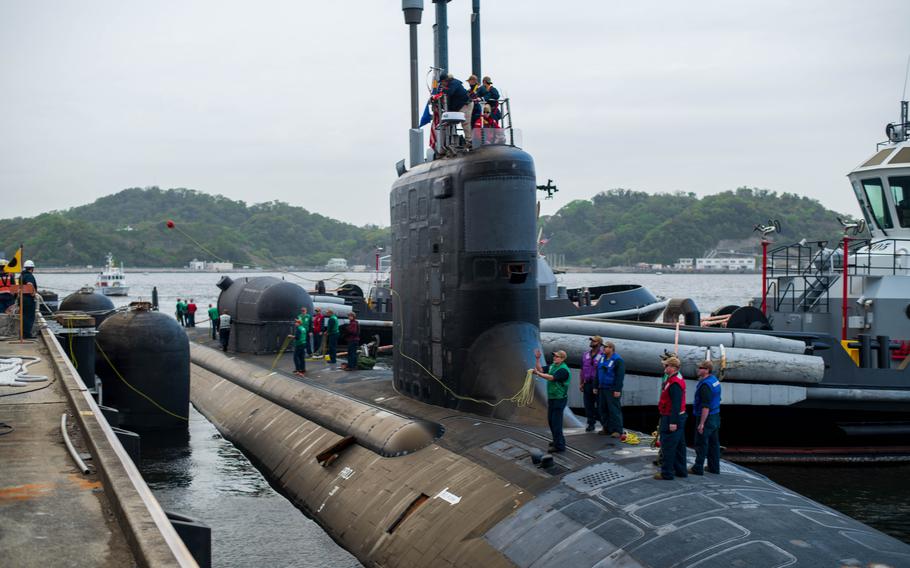
The Virginia-class, fast-attack submarine USS Mississippi arrives at Fleet Activities Yokosuka in Japan for a scheduled port visit, April 18, 2024. (Brandon Holland/U.S. Navy)
WASHINGTON — Lawmakers are resisting plans by the Navy to cut the size of its ship and submarine fleet, rallying behind a push to procure an additional attack submarine and raising alarm about impending ship retirements.
A bipartisan group of 120 House members urged defense appropriators in a letter Wednesday to force the Navy to procure two Virginia-class attack submarines in fiscal 2025, one more than included in the White House’s budget request.
Members of the House Armed Services Committee then added to the pile-on during a hearing with top Navy and Marine Corps officials on Wednesday, criticizing proposals that would shrink U.S. sea power.
“Our sailors and Marines are great but until they can walk on water, we better be building them new ships,” said Rep. Rob Wittman, R-Va.
The Navy’s budget for fiscal 2025, which begins Oct. 1, calls for the construction of six warships, the retirement of 19 ships and the reduction of a two-per-year buy rate of Virginia-class submarines to one.
Lawmakers singled out the submarines as an issue of particular concern due to increased undersea competition from China and Russia and the inking of a deal with Australia to sell the country three nuclear-powered, Virginia-class submarines.
“I don’t see how cutting the size of our fleet and shorting our AUKUS commitment will deter China,” said Rep. Mike Rogers, R-Ala., chairman of the committee. AUKUS refers to a security pact between the U.S., the United Kingdom and Australia to counter China’s growing power in the Indo-Pacific region.
Pentagon officials have said a procurement slowdown of Virginia-class submarines would allow for a “better, healthier dynamic” in the delay-plagued submarine production industry and pay for investments in supply-chain infrastructure.
Navy Secretary Carlos Del Toro said Wednesday that the service would have five additional submarines in its fleet today if the defense industry, which is suffering from workforce shortages, was able to keep up with demand.
“We’re investing $18 billion in the submarine industrial base to actually try to increase the production rates to where they need to be so that we could actually build more submarines and well into the future,” he said.
Lawmakers said they were worried about having enough resources now. They pointed to recent testimony from combatant commanders who said their missions require more attack submarines than the U.S. has in its inventory.
The Navy’s attack submarine fleet is projected to decline to 47 boats in 2030 — a 19-boat deficit from the 66 boats required under the Navy’s shipbuilding plan, according to the letter lawmakers sent appropriators. The fleet now numbers 50 submarines.
Rep. Joe Courtney, D-Conn., said he and other lawmakers will make every effort to add a second Virginia-class submarine to the National Defense Authorization Act, an annual bill specifying expenditures for the Pentagon, and the accompanying appropriations legislation.
“We did it in 2013 when [former President Barack Obama’s] administration eliminated a submarine and then in 2020 when [former President Donald Trump’s] administration eliminated a submarine,” he said. “We — using our constitutional duty Article One, Section Eight, Clause 13 to provide and maintain a Navy — stepped forward and filled that gap, and it’s a good thing we did.”
It is unclear whether lawmakers will challenge the Navy’s other plans for its fleet. The service intends to retire 10 ships that have yet to reach the end of their service life, including two Ticonderoga-class cruisers, four expeditionary transports, two littoral combat ships and one expeditionary transport dock ship.
The cuts will drop the fleet to 287 ships in fiscal 2025 and 280 ships in fiscal 2027, far short of the 355 ships outlined in the Navy’s shipbuilding plan and significantly below the nearly 400 ships that China is expected to have by 2025.
“These retirements represent a huge loss of capability,” Rogers said. “Cutting the buys for new ships, delaying deliveries and decommissioning ships before the end of their service lives will place significant additional stress on readiness of the fleet.”
Adm. Lisa Franchetti, chief of naval operations, said every study that the Navy has done since 2016 shows the service needs to be larger and a 355-ship fleet remains a reasonable goal. But she also cautioned against solely looking at size when judging readiness.
“It isn’t just about the numbers,” she said. “It is about having ready ships, with the munitions, with the right number of people, with the training, that can fight as part of a joint war-fighting ecosystem.”